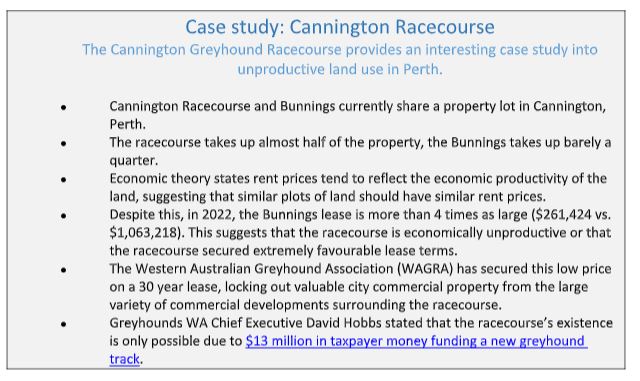Blog
Economist’s review of the IER ReportWe posted about the misleading RWWA funded IER report on greyhound racing in WA. Economist Sebastian Broadhurst reviewed the report and found that the WA IER racing industry report presents a series of misleading assertions and faulty analysis that aims to justify taxpayer support for the greyhound racing industry.
Despite declining popularity and animal safety concerns, Western Australia’s greyhound racing industry persists with taxpayer subsidies and close ties to the state-owned betting agency. The industry commissions misleading economic reports from IER, using fabricated figures and questionable calculation methods to falsely portray its benefits. The below outlines numerous issues with the IER 2023 WA industry report, which was based on 2021-22 data.

Figure 1 : Disparity in full-time workers
IER report inaccurate jobs data
- IER inflates the significance of the WA racing industry by counting the same individuals performing multiple roles as separate people.
- Official ABS data from 2021-22 shows an average of only 1,235 full-time workers in the WA racing industry, while IER claims 10,249 full-time jobs.
- IER’s reported full-time workers in the greyhound racing industry alone almost surpass the actual employees for the entire WA racing industry (including horseracing).
- IER manipulated employment figures represent an overstatement of more than 8 times.
- A throwaway caveat mentions duplication in participation categories, indicating that many participants hold more than one role in the industry.
Attendance figures at Greyhound Racing sites are entirely made-up.
- IER reports 61,528 greyhound racing attendances in 2021-22, despite WAGRA, the racecourse administrator, ceasing attendance recording prior to this period.
o WAGRA states: ‘there are no figures available for the periods 2018/2019’
- IER has not revealed the source of these mystery attendance numbers.
Greyhound owner numbers are inflated
- IER reports 986 greyhound owners, while RWWA reports only 490 in the same period.
- IER’s methodology counts individuals in owner/syndicate groups, however individuals often belong to multiple groups, inflating the reported number of owners.
See below example of Brad Cook being counted 6 times across owner groups.

Figure 2 : Dodgy counting methodology
Direct expenditure figures are just gambling spending
- IER repeatedly highlights $182.1 million of ‘direct expenditure’; in the industry as beneficial economic activity.
- However, 92% of this amount, equivalent to nearly $167.6 million, comes from wagering and racing expenditure dominated by greyhound racing as a ‘strong wagering product’.
- IER conveniently glosses over the fact that the vast majority of expenditure within the greyhound racing industry is related to gambling.
- This reveals greyhound racing as another arm of WA’s gambling industry, despite attempts to portray it as a community based recreational activity.
The IER report fails to complete their economic benefit calculations by omitting negative spillovers, distorting the perceived net benefits of the WA greyhound racing industry.
Negative spillovers include:
- Western Australian’s losing $1.3b in gambling per year.
- Greyhound racing gamblers having the highest average punts. The average Australian gambler spends $133.4 a month on gambling, the average greyhound punter spends almost double at $232.5 per month.
- Significantly less money for local communities and families– Australians lose $24.9b a year on gambling with the highest per capita losses in the world.
- Government expenditure on services to address the demonstrated link between gambling in communities and increases in bankruptcy rates, property theft and family conflict.
- Expenditure on government social services as families of problem gamblers suffer from financial, relational, and emotional problems.
Greyhound racing diverts money away from other industries.
- Spending on greyhound gambling diverts money away from more socially and economically beneficial industries.
- Products differ on an economic scale known as substitution. Substitutable products like greyhound racing divert spending away from other products. Non-substitutable products like petrol and healthcare do not exhibit this trait.
- Gambling spending empirically tends to divert money from recreation and retail sectors, impacting the various retail businesses surrounding the Cannington Greyhound Racecourse.
IER artificially inflates the industry’s size
- IER misuses economic multipliers to inflate perceived benefits of the greyhound industry. IER use this to inflate an already questionable $182.1 million in expenditures up to $225.1 million.
- The Productivity Commission and Chief Economist of WA’s Economic Regulation Authority Treasury have criticized this approach, especially when applied at the state level to single industries (as IER does in their report).
- The Tasmanian Treasury states that applying similar multipliers to all industries would overestimate the size of the economy by 2-3 times.
- The reliability of using multipliers is made even further unreliable when economy’s face supply and labour constraints as WA does currently.
The greyhound racing industry may shrink the WA economy
- The greyhound industry is dragging down the WA economy due to its low productivity which diverts productive resources (land, capital, labour) away from WA’s other industries.
- The industry’s low productivity is evident in IER's own reporting, being 19 times less labour efficient compared to WA’s mining sector.
o Greyhound industry generates $130,191 in value added per worker
o Mining industry generates $2,450,526 in value per worker.
o Greyhound industry is approximately 19 times less labour efficient. - Increasing productivity is crucial for solving WA's economic challenges, according to Professor Alan Duncan, Director of Bankwest Curtin Economics Centre.
- To increase productivity it is important to withdraw support from unproductive industries and prioritize economically and socially beneficial sectors.
Case study: Cannington Racecourse
The Cannington Greyhound Racecourse provides an interesting case study into unproductive land use in Perth.

Conclusion
The WA IER racing industry report presents a series of misleading assertions and faulty analysis that aims to justify taxpayer support for the greyhound racing industry. However, a more rigorous economic analysis would reveal that the actual benefits to the Australian economy from this industry are considerably lower than what IER claims.
Free The Hounds acknowledges the Traditional Owners of country throughout Australia and recognises their continuing connection to land, waters and community. We pay our respects to them and their cultures; and to elders both past and present.


We are committed to building an inclusive culture that celebrates the diversity represented in our community. We welcome all people regardless of age, gender identity, ethnicity, ability, sexuality, faith, religion, and all other identities represented in our community.
